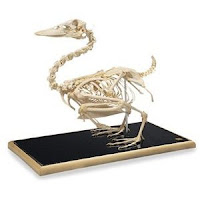1. Endoskeleton
a) Also known as the internal skeleton
b) Located inside the body of all vertebrates including human beings, elephants and fishes.
c) Made up of either bones or cartilage
2. Functions of endoskeleton
a) Supports body weight and maintains body shape
b) Protects soft internal organs
c) Provides points for the attachment of muscles
d) Allows free movement of body and limbs
frog
Duck
Figure 8.1 Animals with endoskeleton
3. Exoskeleton
a) Also called the external skeleton
b) Hard outer skin or shell of intertebrates
c) Made of cuticle or calcium carbonate
d) Examples of animals : Centipede, ant and crab
4. Functions of the exoskeletons
a) Maintains body shape and support body wieght
b) Protects internal organs
c) Provides places for the attachment of muscles
d) Allows movement of body parts
snail
Beetle
Figure 8.2 Animals with exoskeleton
5. Hydrostatic skeleton
a) Consists of a muscular wall which encloses a body cavity that is filled with fluid
b) This body fluid pushes out and exerts pressure in all directiona
c) This body fluid pressure, called hydrostatic pressure gives support and shape to the animal
d) A type of support system for some invertebrates like earthworm, leech, jellyfish and caterpillar
6.Functions of the hydrostatic skeleton
a) Supports and maintains body shape as well as rigidity
b) Supports and protects internal tissues and organs
c) Allows invertebrates to bend, straighten and move
Jellyfish
Earthworm
Figure 8.3 Animals with hydrostatic skeleton
7. The entire body weigh of land vertebrates is supported by the endo skeleton. So they have large and strong skeletons.
8. Land vertebrates have a long column of backbone, strong and big pectoral and pelvic girdles to support their body weight.
9. Birds have hollow bones to enables them to fly.
10. Advantages of hollow bones :
a) Light and strong
b) Allow vertebrates to move faster
c) Require less calcium and phosphorus
Elephant
Whale
Figure 8.4 Skeleton system of elephant and whale
11. Aquatic vertebrates have very small and weak pectoral and pelvic girdles (eg: whales and sharks)
12. A large part of their body weight is supported by the buoyancy of water
13. Buoyancy is the force from water which allows an object to float.











No comments:
Post a Comment